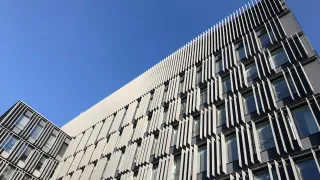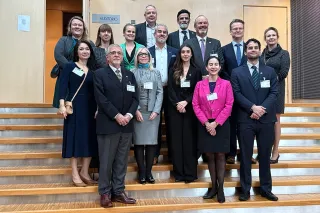VTT FutureHub, the activity-based office of VTT completed in 2020 in Espoo, is not only an office building, but also a versatile research platform – Living Lab. The building forms a local energy system that contains a number of intelligent solutions while supporting VTT's research and piloting.
“VTT FutureHub Living Lab serves as an important platform for our R&D projects and opens up new opportunities for international cooperation, among other things”, says Kari Mäki, Research Professor in Smart Energy Systems.
Solar panels have been installed on the roof, and there are electric car charging points in the yard. The building includes a modern building automation system and several different meters and sensors to collect continuous measurement data. The data is utilised on the Digital Twin platform, on which the building has also been modelled.
Different entities can be controlled either as part of local optimisation or, for example, in flexible markets in accordance with the virtual power plant concept. Machine learning algorithms and artificial intelligence are used in the optimisation. The area also has a 5G test network that contributes to the development of new control and measurement solutions.
The building is utilised in research projects related to local optimisation, virtual power plants, energy communities and regional operator models, for example. It is also integrated into the research laboratories and simulation environments of VTT.
“Thanks to the infrastructure and research environments of VTT Future Hub, the building is a versatile research platform for smart energy. Combining the Living Lab environment and simulations offers entirely new opportunities for both research and piloting. The combination provides us with an excellent tool for creating new business from energy transition for companies”, Mäki explains.
Smart solutions for energy transition
VTT FutureHub Living Lab can be used to develop new solutions for companies and provide answers to questions such as:
- How are the building conditions and user perspective acknowledged as part of active demand response?
- How can local energy management, batteries, solar energy production and electric car charging be brought together under different conditions?
- How are the new micro grid solutions suitable for urban environment by utilising, for example, DC electricity distribution?
- How is the energy community model built in the case of the office building?
- How will sector integration be implemented at the building level?
- How can the data and controllability of the building be utilised in the form of new services?
- What kind of business models can be created for future buildings and local energy systems?
The facilities include a 5G network and accurate positioning
VTT FutureHub has a 5G network and indoor and outdoor positioning devices that can be utilised diversely in research projects.
“We are utilizing the 5G network in the development of various mobile solutions and IoT applications. There are also various measuring devices for developing indoor and outdoor positioning methods. The test platforms can be used in jointly-funded and customer projects and utilised in demonstrating service prototypes”, explains Senior Scientist Tapio Pernu, who led the Living Lab project.












